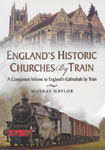|
ENGLAND’S HISTORIC
CHURCHES BY TRAIN
A Companion Volume to England’s Cathedrals by Train
by Murray Naylor
|
 Churches abound throughout England, and while some are more beautiful than others, or more cared-for by the locals, most that survived the Dissolution of the Monasteries, some 16,000, to quote the author’s estimate for the Church of England alone, are still with us, in one form or another. Churches abound throughout England, and while some are more beautiful than others, or more cared-for by the locals, most that survived the Dissolution of the Monasteries, some 16,000, to quote the author’s estimate for the Church of England alone, are still with us, in one form or another.
Not so the railways which, following the great expansion in the 19th century, reached into most communities and corners of the country, and were then pared back considerably in the 1960s. While many churches in this excellent guidebook can indeed be reached by train, there are some that require a taxi or bus ride from the station.
England’s Historic Churches By Train follows a similar theme to Murray Naylor’s England’s Cathedrals by Train, published in 2014 and reviewed in the Winter 2013/14 edition of The Guards Magazine. With so many churches to choose from, the author has made a careful and varied selection, from the large church in Long Melford, Suffolk, built on the riches of the cloth trade and completed in 1484, to Sherborne Abbey with its magnificent vaulted roof, and St Paul’s Church, Jarrow, a small and simple gem dedicated in 685, around the time that Bede entered the adjacent monastery. A remarkable church, made even more so by the bleakness of the surrounding industrial landscape, on the banks of the Tyne and close to South Shields.
The author provides the reader with just the right balance of information about each of the thirty-two churches covered in this book, not attempting a comprehensive architectural commentary, leaving that to the church’s official guide-book. Instead, he gives some background on the history of the place, highlighting interesting and lesser-known facts. As in his book on Cathedrals, the author also provides excellent railway notes, not just the practical guidance on how to get to the destination, but also something of the history of the railways in that part of the country. For example, he discusses some aspects of the Beeching rationalisation in the 1960s, posing the question ‘Was Beeching right?’ He concludes that in some respect he was but in others he was too radical. Some 50 years on, ‘the balance is now being redressed and many routes are once again fulfilling the purpose for which they were originally built nearly two hundred years ago’.
Journeys by train must have a purpose, and the virtue of this excellent book is that it takes the reader off the mainline to some of the more outlying parts of our railway network, to some lovely churches which each have a fascinating story to tell. Trains and churches certainly go together, as this book demonstrates superbly.
The Editor
England’s Historic Churches by Train: A Companion Volume to England’s Cathedrals by Train. Published by Pen & Sword, £25
|
|